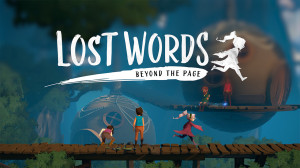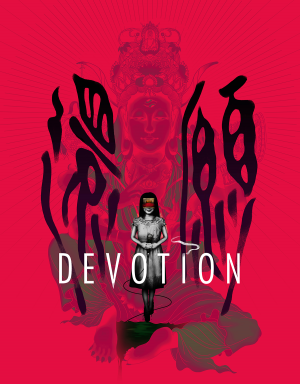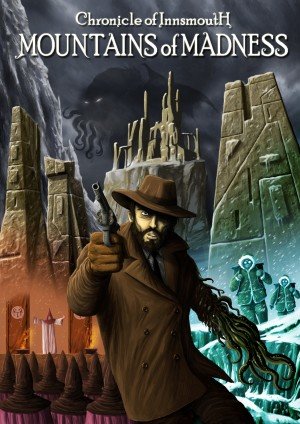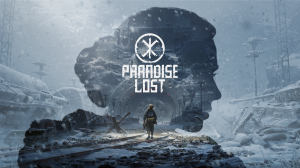Review for Mark & Lara: Partners In Justice
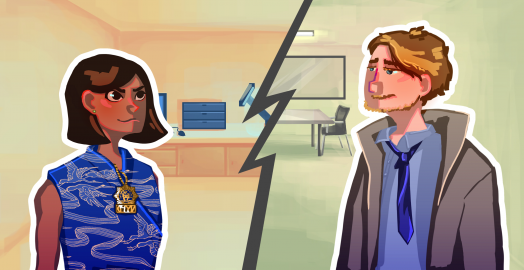
Many of the best detective-style adventure games are cooperative affairs: Holmes has Watson, Gabriel has Grace, George has Nico. And yet each of these has players controlling both characters, alternating between them as necessary. Indie developer Deep Monolith have attempted to emulate the familiar crime-solving experience in Mark & Lara: Partners in Justice, except here you’ll actually need two players to control the titular duo. The crux of the game, and the basis on which the co-op gameplay is built, is that each player will interrogate different characters. Every round of questioning will yield either incomplete information that can be made whole only when combined with your partner’s information, or you could each be given contradictory statements and must work together to find these. It’s a promising idea, but it would have gone so much better with a deeper, more interesting case to crack.
Mark & Lara requires a friend to play with, both of you needing your own copies of the game and to either be in the same room together or communicating over voice chat. You’ll each pick one of the two protagonists to control throughout the investigation. The detectives have their own individual quirks and skills, described in text when choosing between the two. Unfortunately, the game plays exactly the same no matter whom you select, and these particular character traits do not factor into the experience outside of some casual moments during dialogue. Mark, supposedly a maths genius, does not have a chance to demonstrate this ability, nor does Lara get to flex her people-reading skills. It was disappointing that there was no practical difference in gameplay between the two leads, and feels like a missed opportunity. The only deviation in gameplay is which of the two suspects you will be interrogating while your partner simultaneously questions the other.
The game starts with a cutscene of black-and-white images presented in a slideshow, depicting an argument over a poker game, followed by a man dead from apparently hanging himself. This case introduction is nicely drawn for the most part, except when zoomed in close in an attempt to add some cinematic flair, which reveals unsightly jagged edges. Detectives Mark and Lara of the New York Police Department are then presented with a message from the chief, asking them to solve the mystery of the hanged man. “Something about this case stinks,” he remarks, one of the many cliched lines uttered throughout the game. Strangely, he says nothing to justify his reason for suspecting foul play, leaving the detectives with little to go on, which is a somewhat lazy setup for a mystery. Nevertheless, the chief demands that you get a confession from one of the suspects, so once you have perused some documentation outlining the case and providing some basic information about the victim and suspects, the interrogations can begin.
The conversations in Mark & Lara are presented in a visual novel style. A portrait of whichever character is speaking is overlaid against the current backdrop on the opposite side of the screen from their counterpart, with different poses and expressions to coincide with what is being said and a text box displaying their dialogue. When I played, the script had frequent translation errors or some words never localized at all, such as the “continue” button still reading “continua.” The game has been updated since launch, however, and reportedly at least some of these issues have now been addressed. The dialogue itself is decent, and enough personality shines through for both of the suspects to make them more interesting to interrogate. Larry, twice divorced, presents himself with a sad, somewhat forced confidence, while the stuttering Albert seems meek and nervous and is never sure of himself at all.
The character models are quite nice, with thick painted lines and a pleasing colour palette consisting of mellow shades of mostly blues and pinks. Each person has visually unique features to distinguish them: Mark is a bit rough looking but capable, whilst Lara comes across as a little more professional and enthusiastic about the job. This variety contrasts with the very basic environments; there are only two (the interrogation room and the research room), so you would have hoped for more detail than the sparse depiction of some blocky lab equipment or a table in the background.
Each distinct segment tackles a different part of the case, such as how the suspects knew the victim, or their accounts of anything that happened through the fateful night. You are able to bookmark statements that you think may be important by hitting a small star symbol on the dialogue box, which will highlight them for when you review them later. You select which questions to ask (some questions that you don’t choose will be skipped, but this only happens with the trivial ones) in whichever order you like, but once all the options have been exhausted, it’s time for you and your partner to compare statements and do some research.
The research room allows you to read back over everything that has just been said in the interrogations. Each player only has access to their own suspect’s testimony, meaning you will need to communicate verbally with each other to find conflicting information. Every statement has a three-digit number associated with it. There is also a submission box with two separate inputs. When one player has a statement they think contradicts one of their partner’s, each will type the pair of related codes into the submission box. Let’s say, hypothetically, one of the suspects claims that, “I slipped on a banana peel at 4:40,” but the other says, “My friend slipped on an orange peel at 5:00.” When successfully matched, a small conversation between the two investigators is triggered and opens up a new line of questioning based on this discrepancy, unlocking the interrogation room again and allowing you to proceed. You can only proceed together, so when it is time to move on to a new segment, the game will prompt you to wait for your partner to catch up if they’re lagging slightly behind.
This type of system resulted in me and my co-op partner just poring through every single statement until we found two that didn’t match up, which wasn’t a very interesting gameplay loop. We did find ourselves stuck on a couple of occasions, unable to figure out what it was that the game wanted us to submit. There is no penalty for wrong guesses, so after some trial and error, and desperately trying any codes we thought might be slightly associated with each other, we finally cracked it, but we did not feel that these particular submissions were adequately connected. A potentially glaring flaw is that if you ask the same question twice in an interrogation, it will appear in the log twice but with different codes. However, only one of their codes will work when submitted. I was lucky I tried both when this happened to me, or it could have been a very frustrating roadblock.
The research room also has a computer with a search engine. The idea here is that you will be given the name of a potentially significant place or person that you can look up, but this will yield too many results, so you must try to narrow your search with additional information, such as a date. Since each player is running their own separate version of the game, both of you will be required to go through this process in order to each unlock the next segment, since it isn't triggered until your character sees the results. This element provides a better sense of discovery than comparing dialogue, and can also open up a new topic for the next line of questioning.
The game features just a single case, and though it clocked in at just under two hours for me and my partner, I was glad when it was over. The story failed to captivate me even slightly throughout, and I can’t even say that the climax was very exciting. There were some interesting revelations regarding the backstory between suspects, but the method of murder and the resulting cover-up are very basic compared to what we’re used to from series like Ace Attorney or Danganronpa. It may seem unfair to compare a little indie game to the likes of these acclaimed mystery titles, particularly given its low budget price, but the influences are clear as day, with its visual novel style and musical cues timed to break out at eureka moments or when a suspect is cracking under pressure. The music itself is reflective of the game’s inspirations; it’s somewhat cheesy for my taste, but it does well to emulate the retro midi soundtracks of nostalgic older games.
Mark & Lara: Partners in Justice is mildly entertaining as a short bit of investigating with a friend, but most of the enjoyment will be had through your own interactions with your partner rather than the game's efforts to facilitate a fun time. Though it draws inspiration from some of the genre greats, it fails to successfully reproduce the drama and flair that makes those games so compelling. There’s some nice character art and a solid idea for a game here in the way you must work together to find contradictions and form a case, but it does everything strictly by the book, which we all know is the last thing you want in a detective story.









